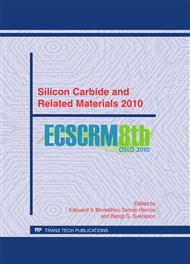p.641
p.645
p.649
p.653
p.657
p.662
p.666
p.670
p.674
Use of Vacuum as a Gate Dielectric: The SiC VacFET
Abstract:
We introduce the vacuum field-effect transistor (VacFET), the first SiC FET to use a vacuum-sealed cavity in place of the traditional, solid gate dielectric. This device architecture eliminates the need to thermally oxidize the SiC surface, a practice which has been widely reported to inhibit the performance and reliability of SiC MOSFETs. Using a combination of batch-compatible electronics and micromachining processing techniques, a polycrystalline SiC bridge is suspended above a 4H-SiC substrate, and the underlying cavity is sealed under vacuum. The fundamental studies made possible by such a device could shed much-needed light on the basic electronic properties of an inverted SiC surface. In this introductory report, we detail the analytical design and fabrication necessary to manufacture the VacFET, and we also demonstrate proof of the concept using turn-on and output characteristics of the first functional SiC device.
Info:
Periodical:
Pages:
657-661
Citation:
Online since:
March 2011
Authors:
Price:
Сopyright:
© 2011 Trans Tech Publications Ltd. All Rights Reserved
Share:
Citation:


